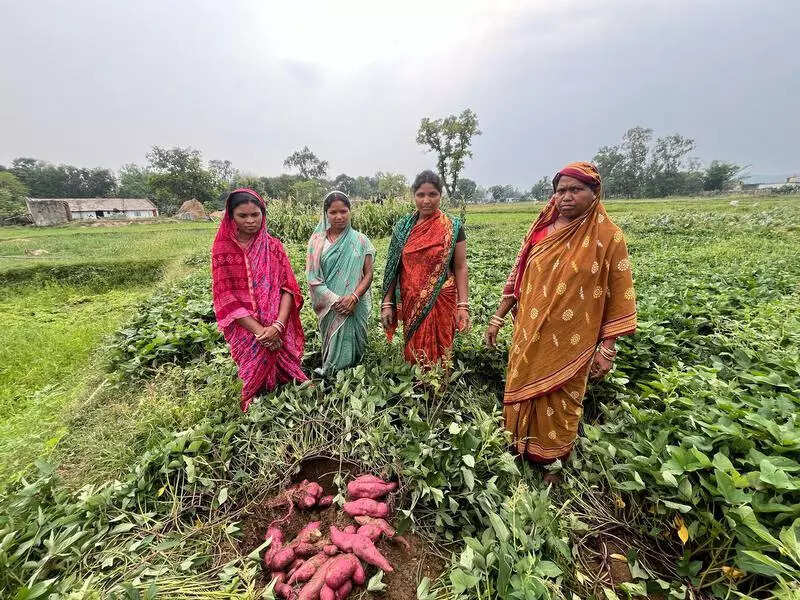Rainbow diet campaign launched in Keonjhar block | Bhubaneswar News

Keonjhar: In a significant step to combat malnutrition among tribal communities, the Indian Council of Agricultural Research – Central Tuber Crops Research Institute (ICAR-CTCRI), in collaboration with the Keonjhar district horticulture department, has launched the rainbow diet campaign (RDC) in the Juang-inhabited Banspal block in Keonjhar district.
As part of the initiative, the orange-fleshed sweet potato (OFSP)variety SP 95/4 was introduced in Mukuna, Nuagaon, and Sendkap villages of the Sadar block, covering 6.5 hectares. According to a press release from the district administration, a sample harvest at Nuagaon village yielded a bumper 35–40 tonnes per hectare—nearly four times the national average of 10.58 tonnes per hectare.
Deputy director of horticulture, Keonjhar, Soumendra Panigrahi, said, “It will succeed in this district. Later on, the seeds will be distributed to other areas for mass cultivation.”
An ICAR-CTCRI team also conducted a baseline nutrition survey in Juang villages, including Barhagad, Hatisila, Jantari, Guptaganga, Bayakumutia, and Kanthadas, to assess dietary patterns and prepare for the next phase of the campaign.
Members of the survey team said that over the next three years, crops harvested from Sadar block will be used to produce customised food products — such as noodles, pasta, cookies, cakes, and chips — targeted at improving nutrition among 600 Juang children (aged 6–9) and adolescents (10–19) in the Banspal block. According to them, a centralised food processing facility for mass production of these items is expected to be operational by the end of 2025.
As per a survey team member, the project will rely entirely on local produce and involve local food processing units and self-help groups to create a sustainable community-led nutrition model.
All in all, the project’s objective is to analyse the local food system, identify the root causes of malnutrition, and eliminate both malnutrition and micronutrient deficiencies among children. Additionally, the project aims to design customised rainbow food matrices based on local food preferences, optimise their nutritional quality, and develop a district-level satellite incubation mechanism for the micro-management of value chain development and nutritional interventions, among other goals.
As part of the initiative, the orange-fleshed sweet potato (OFSP)variety SP 95/4 was introduced in Mukuna, Nuagaon, and Sendkap villages of the Sadar block, covering 6.5 hectares. According to a press release from the district administration, a sample harvest at Nuagaon village yielded a bumper 35–40 tonnes per hectare—nearly four times the national average of 10.58 tonnes per hectare.
Deputy director of horticulture, Keonjhar, Soumendra Panigrahi, said, “It will succeed in this district. Later on, the seeds will be distributed to other areas for mass cultivation.”
An ICAR-CTCRI team also conducted a baseline nutrition survey in Juang villages, including Barhagad, Hatisila, Jantari, Guptaganga, Bayakumutia, and Kanthadas, to assess dietary patterns and prepare for the next phase of the campaign.
Members of the survey team said that over the next three years, crops harvested from Sadar block will be used to produce customised food products — such as noodles, pasta, cookies, cakes, and chips — targeted at improving nutrition among 600 Juang children (aged 6–9) and adolescents (10–19) in the Banspal block. According to them, a centralised food processing facility for mass production of these items is expected to be operational by the end of 2025.
As per a survey team member, the project will rely entirely on local produce and involve local food processing units and self-help groups to create a sustainable community-led nutrition model.
All in all, the project’s objective is to analyse the local food system, identify the root causes of malnutrition, and eliminate both malnutrition and micronutrient deficiencies among children. Additionally, the project aims to design customised rainbow food matrices based on local food preferences, optimise their nutritional quality, and develop a district-level satellite incubation mechanism for the micro-management of value chain development and nutritional interventions, among other goals.
















